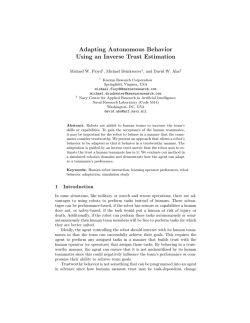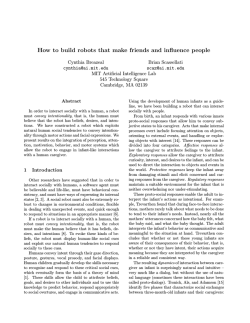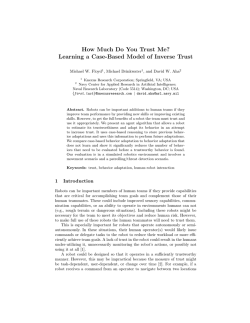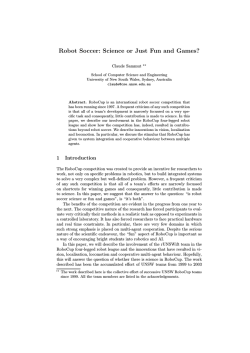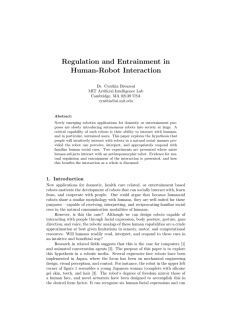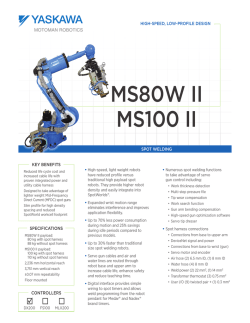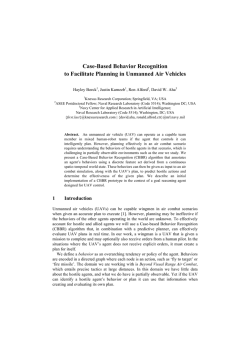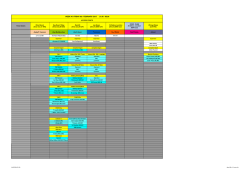
Case-Based Behavior Adaptation Using an Inverse Trust Metric
Case-Based Behavior Adaptation Using an Inverse Trust Metric
Michael W. Floyd and Michael Drinkwater
Knexus Research Corporation
Springfield, Virginia, USA
{michael.f loyd, michael.drinkwater}@knexusresearch.com
David W. Aha
Navy Center for Applied Research in Artificial Intelligence
Naval Research Laboratory (Code 5514)
Washington, DC, USA
[email protected]
Abstract
Robots are added to human teams to increase the
team’s skills or capabilities but in order to get
the full benefit the teams must trust the robots.
We present an approach that allows a robot to
estimate its trustworthiness and adapt its behavior accordingly. Additionally, the robot uses casebased reasoning to store previous behavior adaptations and uses this information to perform future adaptations. In a simulated robotics domain,
we compare case-based behavior adaption to behavior adaptation that does not learn and show it
significantly reduces the number of behaviors that
need to be evaluated before a trustworthy behavior is found.
1
Introduction
Robots can be important members of human teams
if they provide capabilities that humans do not have.
These could include improved sensory capabilities, communication capabilities, or an ability to operate in environments humans can not (e.g., rough terrain or dangerous situations). Adding these robots might be necessary for the team to meet its objectives and reduce
human risk. However, to make full use of the robots
the teammates will need to trust them.
This is especially important for robots that operate
autonomously or semi-autonomously. In these situations, the human teammates would likely issue commands or delegate tasks to the robot to reduce their
workload or more efficiently achieve team goals. A lack
of trust in the robot could result in the humans underutilizing the it, unnecessarily monitoring the robot’s actions, or possibly not using it at all.
A robot could be designed so that it operates in a
sufficiently trustworthy manner. However, this may be
impractical because the measure of trust might be taskdependent, user-dependent, or change over time (Desai
et al. 2013). For example, if a robot receives a command
from an operator to navigate between two locations in
Copyright c 2014, Association for the Advancement of Artificial Intelligence (www.aaai.org). All rights reserved.
a city, one operator might prefer the task be performed
as quickly as possible whereas another might prefer the
task be performed as safely as possible (e.g., avoiding
bumping into any obstacles). Each operator has distinct preferences that influence how they will trust the
robot’s behavior, and these preferences may conflict.
Even if these user preferences were known in advance,
a change in context could also influence what behaviors
are trustworthy. An operator who generally prefers a
task to be performed quickly would likely change that
preference if the robot was transporting hazardous material, whereas an operator who prefers safety would
likely change their preferences in an emergency situation.
The ability of a robot to behave in a trustworthy
manner regardless of the operator, task, or context requires that it can evaluate its trustworthiness and adapt
its behavior accordingly. The robot may not get explicit
feedback about its trustworthiness but will instead need
to estimate its trustworthiness based on its interactions
with its operator. Such an estimate, which we refer
to as an inverse trust estimate, differs from traditional
computational trust metrics in that it measures how
much trust another agent has in the robot rather than
how much trust the robot has in another agent. In this
paper we examine how a robot can estimate the trust an
operator has in it, adapt its behavior to become more
trustworthy, and learn from previous adaptations so it
can perform trustworthy behaviors more quickly.
In the remainder of this paper we will describe our
behavior adaptation approach and evaluate it in a simulated robotics domain. Section 2 presents the inverse
trust metric and Section 3 describes how it can be used
to guide the robot’s behavior. In Section 4, we evaluate
our case-based behavior adaptation strategy in a simulated robotics domain and report evidence that it can
efficiently adapt the robot’s behavior to the operator’s
preferences. Related work is examined in Section 5 followed by a discussion of future work and concluding
remarks in Section 6.
2
Inverse Trust Estimation
Traditional trust metrics are used to estimate the trust
an agent should have in other agents (Sabater and
Sierra 2005). The agent can use past interactions with
those agents or feedback from others to determine their
trustworthiness. The information this agent uses is
likely internal to it and not directly observable by a
third party. In a robotics context, the robot will not be
able to observe the information a human operator uses
to assess their trust in it. Instead, the robot will need
to obtain this internal information to estimate operator
trust.
One option would be to directly ask the operator, either as it is interacting with the robot (Kaniarasu et
al. 2013) or after the task has been completed (Jian,
Bisantz, and Drury 2000; Muir 1987), about how trustworthy the robot was behaving. However, this might
not be practical in situations that are time-sensitive or
where there would be a significant delay between when
the robot wishes to evaluate its trustworthiness and the
next opportunity to ask the operator (e.g., during a
multi-day search and rescue mission). An alternative
that does not require direct operator feedback is for
the robot to infer the trust the operator has in it.
Factors that influence human-robot trust can be
grouped into three main categories (Oleson et al.
2011): robot-related factors (e.g., performance, physical attributes), human-related factors (e.g., engagement, workload, self-confidence), and environmental
factors (e.g., group composition, culture, task type).
Although these factors have all been shown to influence
human-robot trust, the strongest indicator of trust is
robot performance (Hancock et al. 2011; Carlson et al.
2014). Kaniarasu et al. (2012) have used an inverse
trust metric that estimates robot performance based
on the number of times the operator warns the robot
about its behavior and the number of times the operator takes manual control of the robot. They found this
metric aligns closely with the results of trust surveys
performed by the operators. However, this metric does
not take into account factors of the robot’s behavior
that increase trust.
The inverse trust metric we use is based on the number of times the robot completes an assigned task, fails
to complete a task, or is interrupted while performing a task. An interruption occurs when the operator
tells the robot to stop its current autonomous behavior.
Our robot infers that any interruptions are a result of
the operator being unsatisfied with the robot’s performance. Similarly, our robot assumes the operator will
be unsatisfied with any failures and satisfied with any
completed tasks. Interrupts could also be a result of
a change in the operator’s goals, or failures could be a
result of unachievable tasks, but the robot works under
the assumption that those situations occur rarely.
Our control strategy estimates whether trust is increasing, decreasing, or remaining constant over periods of time related to how long the robot has been
performing its current behavior. For example, if the
robot modifies its behavior at time tA in an attempt
to perform more trustworthy behavior, the trust value
will be estimated using information from tA onward.
We evaluate the trust value between times tA and tB
as follows:
n
wi × cmdi ,
T rustA−B =
i=1
where there were n commands issued to the robot between tA and tB . If the ith command (1 ≤ i ≤ n)
was interrupted or failed it will decrease the trust value
and if it was completed successfully it will increase the
trust value (cmdi ∈ {−1, 1}). The ith command will
also receive a weight (wi = [0, 1]) related to the robot’s
behavior (e.g., a command that was interrupted because
the robot performed a behavior slowly would likely be
weighted less than an interruption because the robot
injured a human).
3
Trust-Guided Behavior Adaptation
Using Case-Based Reasoning
The robot uses the inverse trust estimate to infer if its
current behavior is trustworthy, is not trustworthy, or
it does not yet know. Two threshold values are used
to identify trustworthy and untrustworthy behavior:
the trustworthy threshold (τT ) and the untrustworthy
threshold (τU T ). Our robot uses the following tests:
• If the trust value reaches the trustworthy threshold
(T rustA−B ≥ τT ), the robot will conclude it has
found a sufficiently trustworthy behavior.
• If the trust value falls below the untrustworthy
threshold (T rustA−B ≤ τU T ), the robot will modify
its behavior in an attempt to use a more trustworthy
behavior.
• If the trust value is between the two thresholds
(τU T < T rustA−B < τT ), the robot will continue
to evaluate the operator’s trust.
In the situations where the trustworthy threshold has
been reached or neither threshold has been reached,
the robot will continue to use its current behavior.
However, when the untrustworthy threshold has been
reached the robot will modify its behavior in an attempt to behave in a more trustworthy manner. The
ability of the robot to modify its own behavior is guided
by the number of behavioral components that it can
modify. These modifiable components could include
changing an algorithm used (e.g., switching between
two path planning algorithms), changing parameter values it uses, or changing data that is being used (e.g.,
using a different map of the environment). Each modifiable component i will have a set Ci of possible values
that the component can be selected from.
If the robot has m components of its behavior that
can be modified, its current behavior B will be a tuple containing the currently selected value ci for each
modifiable component (ci ∈ Ci ):
B = c1 , c2 , . . . , cm
When a behavior B was found by the robot to be untrustworthy it is stored as an evaluated pair E that also
contains the time t it took the behavior to be labeled
as untrustworthy:
E = B, t
The time it took for a behavior to reach the untrustworthy threshold is used to compare behaviors that have
been found to be untrustworthy. A behavior B that
reaches the untrustworthy threshold sooner than another behavior B (t < t ) is assumed to be less trustworthy than the other. This is based on the assumption
that if a behavior took longer to reach the untrustworthy threshold then it was likely performing some trustworthy behaviors or was not performing untrustworthy
behaviors as quickly.
As the robot evaluates behaviors, it stores a set
Epast of previously evaluated behaviors (Epast =
{E1 , E2 , . . . , En }). It continues to add to this set until it locates a trustworthy behavior Bf inal (when the
trustworthy threshold is reached). The set of evaluated
behaviors can be thought of as the search path that
resulted in the final solution (the trustworthy behavior). The search path information is potentially useful
because if the robot can determine it is on a similar
search path that it has previously encountered (similar behaviors being labeled untrustworthy in a similar
amount of time) then the robot can identify what final
behavior it should attempt. To allow for the reuse of
past behavior adaptation information we use case-based
reasoning (Richter and Weber 2013).
Each case C is composed of a problem and a solution.
In our context, the problem is the previously evaluated
behaviors and the solution is the final trustworthy behavior:
C = Epast , Bf inal
These cases are stored in a case base and represent the
robot’s knowledge about previous behavior adaptation.
When the robot modifies its behavior it selects new
values for one or more of the modifiable components.
The new behavior Bnew is selected as a function of all
behaviors that have been previously evaluated for this
operator and its case base CB:
Bnew = selectBehavior(Epast , CB)
The selectBehavior function (Algorithm 1) attempts
to use previous adaptation experience to guide the current adaptation. The algorithm iterates through each
case in the case base and checks to see if that case’s
final behavior has already been evaluated by the robot.
If the behavior has been evaluated, that means the
robot has already found the behavior to be untrustworthy so the robot does not try to use it again. The
remaining cases have their set of evaluated behaviors
(Ci .Epast ) compared to the robot’s current set of evaluated behaviors (Epast ). The most similar case’s final
behavior is returned and will be used by the robot. If
no such behaviors are found (the final behaviors of all
cases have been examined or the case base is empty),
the modif yBehavior function is used to select the next
behavior to perform. It selects an evaluated behavior Emax that took the longest to reach the untrustworthy threshold (∀Ei ∈ Epast (Emax .t ≥ Ei .t)) and
performs a random walk (without repetition) to find
a behavior Bnew that required the minimum number of
changes from Emax .B and has not already been evaluated (∀Ei ∈ Epast (Bnew = Ei .B)). If all possible behaviors have been evaluated and found to be untrustworthy
the robot will stop adapting its behavior and use the
behavior from Emax .
Algorithm 1: Selecting a New Behavior
Function: selectBehavior(Epast , CB) returns
Bnew ;
bestSim ← 0; Bbest ← ∅;
foreach Ci ∈ CB do
if Ci .Bf inal ∈
/ Epast then
simi ← sim(Epast , Ci .Epast );
if simi > bestSim then
bestSim ← simi ;
Bbest ← Ci .Bf inal ;
if Bbest = ∅ then
Bbest ← modif yBehavior(Epast );
return Bbest ;
The similarity between two sets of evaluated behaviors (Algorithm 2) is complicated by the fact that the
sets may vary in size. The size of the sets depend on the
number of previous behaviors that were evaluated by
the robot in each set and there is no guarantee that the
sets contain identical behaviors. To account for this, the
similarity function looks at the overlap between the two
sets and ignores behaviors that have been examined in
only one of the sets. Each evaluated behavior in the first
set has its behavior matched to an evaluated behavior
Emax in the second set that contains the most similar
m
1
behavior (sim(BA , BB ) = m
i=1 sim(BA .ci , BB .ci ),
where the similarity function will depend on the specific type of behavior component). If those behaviors
are similar enough, based on a threshold λ, then the
similarity of the time components of these evaluated behaviors are included in the similarity calculation. This
ensures that only matches between evaluated behaviors
that are highly similar (i.e., similar behaviors exist in
both sets) are included in the similarity calculation.
4
Evaluation
In this section, we describe an evaluation for our claim
that the case-based reasoning approach is able to adapt
Algorithm 2: Similarity between sets of evaluated
behaviors
Function: sim(EA , EB ) returns sim;
totalSim ← 0; num ← 0;
foreach Ei ∈ EA do
Emax ← arg max (sim(Ei .B, Ej .B));
Ej ∈EB
if sim(Ei .B, Emax .B) > λ then
totalSim ← totalSim+sim(Ei .t, Emax .t);
num ← num + 1;
if num = 0 then
return 0;
return
totalSim
num ;
to and perform trustworthy behaviors more quickly that
a random walk approach. We conducted this study in
a simulated environment with a simulated robot and
operator.
4.1
eBotWorks Simulator
Our evaluation uses the eBotworks simulation environment (Knexus Research Corporation 2013). eBotworks
is a multi-agent simulation engine and testbed that allows for multimodal command and control of unmanned
systems. It allows for autonomous agents to control
simulated robotic vehicles while interacting with human operators, and for the autonomous behavior to be
observed and evaluated.
We use a simulated urban environment (Figure 1)
containing landmarks (e.g., roads) and objects (e.g.,
houses, humans, traffic cones, vehicles, road barriers). The robot is a wheeled unmanned ground vehicle
(UGV) and uses eBotwork’s built-in natural language
processing (for interpreting user commands), locomotion, and path-planning modules. The actions performed by a robot in eBotworks are non-deterministic
(e.g., the robot cannot anticipate its exact position after
moving).
Figure 1: Simulated urban environment in eBotworks
4.2
Simulated Operator
In this study we will use a simulated operator to issue
commands to the robot. The simulated operator assesses its trust in the robot using three factors of the
robot’s performance:
• Task duration: The simulated operator has an expectation about the amount of time that the task
will take to complete (tcomplete ). If the robot does
not complete the task within that time, the operator may, with probability pα , interrupt the robot and
issue another command.
• Task completion: If the operator determines that
the robot has failed to complete the task (e.g., the
UGV is stuck), it will interrupt.
• Safety: The operator may interrupt the robot, with
probability pγ , if the robot collides with any obstacles
along the route.
4.3
Movement Scenario
The simple task the robot is required to perform involves moving between two locations in the environment. At the start of each run, the robot will be placed
in the environment and the simulated operator will issue a command for the robot to move to a goal location. Based on the robot’s performance (task duration,
task completion, and safety), the operator will allow
the robot to complete the task or interrupt it. When
the robot completes a task, fails to complete it, or is
interrupted, the scenario will be reset by placing the
robot back at the start location and the operator will
issue another command.
We us three simulated operators:
• Speed-focused operator: This operator prefers
the robot to move to the destination quickly regardless of whether it hits any obstacles (tcomplete = 15
seconds, pα = 95%, pγ = 5%).
• Safety-focused operator: This operator prefers
the robot to avoid obstacles regardless of how long
it takes to reach the destination (tcomplete = 15 seconds, pα = 5%, pγ = 95%).
• Balanced operator: This operator prefers a balanced mixture of speed and safety (tcomplete = 15
seconds, pα = 95%, pγ = 95%).
Each of the three simulated operators will control the
robot for 500 experimental trials, with each trial terminating when the robot determines it has found a trustworthy behavior. For the case-based approach, a case
is added to the case base at the end of any trial where
the robot performs at least one random walk adaptation of its behavior. When no random walk adaptations
are performed, the robot was able to find a trustworthy
behavior using the cases in its case base so there is no
need to add another case.
The robot has two modifiable behavior components:
speed (meters per second) and obstacle padding (meters). Speed relates to how fast the robot can move
and obstacle padding relates to the distance the robot
will attempt to keep from obstacles during movement.
The set of possible values for each modifiable component (Cspeed and Cpadding ) are determined from minimum and maximum values with fixed increments.
Cspeed
Cpadding
=
=
{0.5, 1.0, . . . , 10.0}
{0.1, 0.2, 0.3, . . . , 2.0}
We test our robot using a trustworthy threshold of
τT = 5.0 and an untrustworthy threshold of τU T =
−5.0. When calculating the similarity between sets of
evaluated behaviors the robot uses a similarity threshold of λ = 0.95 (behaviors must be 95% similar to be
matched).
4.4
Results
We found that both the case-based behavior adaptation and the random walk behavior adaptation strategies resulted in similar trustworthy behaviors for each
simulated operator. For the speed-focused operator, the
trustworthy behaviors had higher speeds regardless of
padding (3.5 ≤ speed ≤ 10.0, 0.1 ≤ padding ≤ 1.9).
The safety-focused operator had higher padding regardless of speed (0.5 ≤ speed ≤ 10.0, 0.4 ≤ padding ≤ 1.9).
Finally, the balanced operator had higher speed and
higher padding (3.5 ≤ speed ≤ 10.0, 0.4 ≤ padding ≤
1.9). In addition to having similar value ranges, there
were no statistically significant differences between the
distributions of those values for the two strategies.
The difference between the two behavior adaption approaches was related to the number of behaviors that
needed to be evaluated before a trustworthy behavior
was found. Table 1 shows the mean number of evaluated behaviors (and 95% confidence interval) when interacting with each operator type (over 500 trials for
each operator). In addition to being controlled by only
a single operator, we also examined a condition in which
the operator is selected at random with equal probability. This represents a more realistic scenario where the
robot will be required to interact with a variety of operators without any knowledge about which operator will
control it.
Table 1: The mean number of behaviors evaluated
Operator
Speed-focused
Safety-focused
Balanced
Random
Random Walk
20.3 (±3.4)
2.8 (±0.3)
27.0 (±3.8)
14.6 (±2.9)
Case-based
1.6 (±0.2)
1.3 (±0.1)
1.8 (±0.2)
1.6 (±0.1)
The case-based approach required significantly fewer
behaviors to be evaluated in all four experiments (using
a paired t-test with p < 0.01). This is because the casebased approach was able to learn from previous adaptations and use that information to quickly find trustworthy behaviors. At the beginning, when the robot’s case
base is empty, the case-based approach is required to
perform adaptation that is similar to the random walk
approach. As the case base size grows, the number
of times random walk adaptation is required decreases
until the agent generally only performs a single casebased behavior adaptation before finding a trustworthy behavior. Even when the case base contains cases
from all three simulated operators, the case-based approach can quickly differentiate between the users and
select a trustworthy behavior. The number of adaptations required for the safety-focused operator was lower
than for the other operators because a higher percentage of behaviors are considered trustworthy. The robot,
which started the experiments for each operator with
an empty case base, collected 24 cases when interacting
with the speed-focused operator, 18 cases when interacting with the safety-focused operator, 33 cases when
interacting with the balanced operator, and 33 cases
when interacting with a random operator.
The primary limitation of the case-based approach is
that it relies on the random walk search when it does
not have any suitable cases to use. Although the mean
number of behaviors evaluated by the case-based approach is low, the situations where random walk is used
(and a new case is created) require an above-average
number of behaviors to be evaluated (closer to the mean
number of behaviors evaluated when only random walk
is used). The case-based approach uses random walk
infrequently, so there is not a large impact on the mean
number of behaviors evaluated over 500 trials, but this
would be an important concern as the problem scales to
use more complex behaviors with more modifiable components. Two primary solutions exist to improve performance in more complex domains: improved search
and seeding of the case base. Random walk search was
used because it requires no explicit knowledge about the
domain or the task. However, a more intelligent search
that could identify relations between interruptions and
modifiable components (e.g., an interruption when the
robot is very close to objects requires a change to the
padding value) would likely improve adaptation time.
Since a higher number of behaviors need to be evaluated when new cases are created, if a set of initial cases
were provided to the robot it would be able to decrease
the number of random walk adaptations (or adaptations
requiring a different search technique) it would need to
perform.
5
Related Work
In addition to Kaniarasu et al. (2012), Saleh et al.
(2012) have also proposed a measure of inverse trust
and use a set of expert-authored rules to measure trust.
Unlike our own work, while these approaches measure
trust, they do not use this information to adapt behavior. Shapiro and Shachter (2002) discuss the need
for an agent to act in the best interests of a user even
if that requires sub-optimal performance. Their work
examines identifying factors that influence the user’s
utility function and updating the agent’s reward function accordingly. This is similar to our own work in
that behavior is modified to align with a user’s prefer-
ence, but our robot is not given an explicit model of the
user’s reasoning process.
Conversational recommender systems (McGinty and
Smyth 2003) iteratively improve recommendations to
a user by tailoring the recommendations to the user’s
preferences. As more information is obtained through
dialogs with a user, these systems refine their model of
that user. Similarly, learning interface agents observe
a user performing a task (e.g., sorting e-mail (Maes
and Kozierok 1993) or schedule management (Horvitz
1999)) and learn the user’s preferences. Both conversational recommender systems and learning interface
agents are designed to learn preferences for a single
task whereas our behavior adaptation requires no prior
knowledge about what tasks will be performed.
Our work also has similarities to other areas of learning during human-robot interactions. When a robot
learns from a human, it is often beneficial for the robot
to understand the environment from the perspective of
the human. Breazeal et al. (2009) have examined how
a robot can learn from a cooperative human teacher by
mapping its sensory inputs to how it estimates the human is viewing the environment. This allows the robot
to learn from the viewpoint of the teacher and possibly
discover information it would not have noticed from its
own viewpoint. This is similar to preference-based planning systems that learn a user’s preferences for plan
generation (Li, Kambhampati, and Yoon 2009). Like
our own work, these systems involve inferring information about the reasoning of a human. However, they
differ in that they involve observing a teacher demonstrate a specific task and learning from those demonstrations.
6
Conclusions
In this paper we have presented an inverse trust measure to estimate an operator’s trust in a robot’s behavior and to adapt its behavior to increase an operator’s
trust. The robot also learns from previous behavior
adaptations using case-based reasoning. Each time it
successfully finds a trustworthy behavior, it records that
behavior as well as the untrustworthy behaviors that it
evaluated.
We evaluated our trust-guided behavior adaptation
algorithm in a simulated robotics environment by comparing it to a behavior adaptation algorithm that does
not learn from previous adaptations. Both approaches
converge to trustworthy behaviors for each type of operator (speed-focused, safety-focused and balanced) but
the case-based algorithm requires significantly fewer behaviors to be evaluated before a trustworthy behavior
is found. This is advantageous because the chances
that the operator will stop using the robot increases
the longer the robot is behaving in an untrustworthy
manner.
Although we have shown the benefits of trust-guided
behavior adaptation, several areas of future work exist. We have only evaluated the behavior in a simple
movement scenario but will soon test it on increasingly
complex tasks where the robot has more behavior components that it can modify (e.g., scouting for hazardous
devices in an urban environment). In longer scenarios
it may be important to not only consider undertrust,
as we have done in this work, but also overtrust. In situations of overtrust, the operator may trust the robot
too much and allow the robot to behave autonomously
even when it is performing poorly. We also plan to include other trust factors in the inverse trust estimate
and add mechanisms that promote transparency between the robot and operator. More generally, adding
an ability for the robot to reason about its own goals
and the goals of the operator would allow the robot to
verify it is trying to achieve the same goals as the operator and identify any unexpected goal changes (e.g.,
such as when a threat occurs).
Acknowledgments
Thanks to the Naval Research Laboratory and the Office of Naval Research for supporting this research.
References
Breazeal, C.; Gray, J.; and Berlin, M. 2009. An embodied cognition approach to mindreading skills for socially
intelligent robots. International Journal of Robotic Research 28(5).
Carlson, M. S.; Desai, M.; Drury, J. L.; Kwak, H.; and
Yanco, H. A. 2014. Identifying factors that influence
trust in automated cars and medical diagnosis systems.
In AAAI Symposium on The Intersection of Robust Intelligence and Trust in Autonomous Systems, 20–27.
Desai, M.; Kaniarasu, P.; Medvedev, M.; Steinfeld, A.;
and Yanco, H. 2013. Impact of robot failures and feedback on real-time trust. In 8th International Conference
on Human-robot Interaction, 251–258.
Hancock, P. A.; Billings, D. R.; Schaefer, K. E.; Chen,
J. Y.; De Visser, E. J.; and Parasuraman, R. 2011. A
meta-analysis of factors affecting trust in human-robot
interaction. Human Factors: The Journal of the Human
Factors and Ergonomics Society 53(5):517–527.
Horvitz, E. 1999. Principles of mixed-initiative user
interfaces. In 18th Conference on Human Factors in
Computing Systems, 159–166.
Jian, J.-Y.; Bisantz, A. M.; and Drury, C. G. 2000.
Foundations for an empirically determined scale of trust
in automated systems. International Journal of Cognitive Ergonomics 4(1):53–71.
Kaniarasu, P.; Steinfeld, A.; Desai, M.; and Yanco,
H. A. 2012. Potential measures for detecting trust
changes. In 7th International Conference on HumanRobot Interaction, 241–242.
Kaniarasu, P.; Steinfeld, A.; Desai, M.; and Yanco,
H. A. 2013. Robot confidence and trust alignment.
In 8th International Conference on Human-Robot Interaction, 155–156.
Knexus Research Corporation.
2013.
eBotworks. http://www.knexusresearch.com/products/
ebotworks.php. [Online; accessed April 9, 2014].
Li, N.; Kambhampati, S.; and Yoon, S. W. 2009. Learning probabilistic hierarchical task networks to capture
user preferences. In 21st International Joint Conference
on Artificial Intelligence, 1754–1759.
Maes, P., and Kozierok, R. 1993. Learning interface
agents. In 11th National Conference on Artificial Intelligence, 459–465.
McGinty, L., and Smyth, B. 2003. On the role of diversity in conversational recommender systems. In 5th International Conference on Case-Based Reasoning. 276–
290.
Muir, B. M. 1987. Trust between humans and machines,
and the design of decision aids. International Journal
of Man-Machine Studies 27(56):527–539.
Oleson, K. E.; Billings, D. R.; Kocsis, V.; Chen, J. Y.;
and Hancock, P. A. 2011. Antecedents of trust in
human-robot collaborations. In 1st International MultiDisciplinary Conference on Cognitive Methods in Situation Awareness and Decision Support, 175–178.
Richter, M. M., and Weber, R. O. 2013. Case-Based
Reasoning - A Textbook. Springer.
Sabater, J., and Sierra, C. 2005. Review on computational trust and reputation models. Artificial Intelligence Review 24(1):33–60.
Saleh, J. A.; Karray, F.; and Morckos, M. 2012. Modelling of robot attention demand in human-robot interaction using finite fuzzy state automata. In International Conference on Fuzzy Systems, 1–8.
Shapiro, D., and Shachter, R. 2002. User-agent value
alignment. In Stanford Spring Symposium - Workshop
on Safe Learning Agents.
© Copyright 2025
